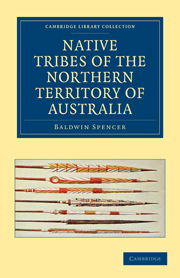Book contents
- Frontmatter
- Preface
- NOTE
- Contents
- LIST OF ILLUSTRATIONS
- CHAPTER I INTRODUCTION
- CHAPTER II SOCIAL ORGANISATION AND MARRIAGE REGULATIONS
- CHAPTER III INITIATION CEREMONIES
- CHAPTER IV TOTEMIC SYSTEMS AND TOTEM GROUPS
- CHAPTER V SACRED STICKS, BULL-ROARERS, AND CEREMONIAL OBJECTS
- CHAPTER VI BURIAL AND MOURNING CEREMONIES
- CHAPTER VII MAGIC AND MEDICINE
- CHAPTER VIII BELIEFS IN REGARD TO THE ORIGIN OF CHILDREN
- CHAPTER IX TRADITIONS CONCERNING IMBEROMBERA, THE GREAT ANCESTOR, AND ALSO OTHER ANCESTORS OF THE KAKADU NATION
- CHAPTER X VARIOUS TRADITIONS, CUSTOMS, AND BELIEFS
- CHAPTER XI FOOD RESTRICTIONS
- CHAPTER XII WEAPONS AND IMPLEMENTS
- CHAPTER XIII CLOTHING AND ORNAMENT
- CHAPTER XIV DECORATIVE ART
- APPENDIX
- GLOSSARY OF NATIVE TERMS
- INDEX
- Plate section
- Plate section
CHAPTER II - SOCIAL ORGANISATION AND MARRIAGE REGULATIONS
Published online by Cambridge University Press: 05 July 2011
- Frontmatter
- Preface
- NOTE
- Contents
- LIST OF ILLUSTRATIONS
- CHAPTER I INTRODUCTION
- CHAPTER II SOCIAL ORGANISATION AND MARRIAGE REGULATIONS
- CHAPTER III INITIATION CEREMONIES
- CHAPTER IV TOTEMIC SYSTEMS AND TOTEM GROUPS
- CHAPTER V SACRED STICKS, BULL-ROARERS, AND CEREMONIAL OBJECTS
- CHAPTER VI BURIAL AND MOURNING CEREMONIES
- CHAPTER VII MAGIC AND MEDICINE
- CHAPTER VIII BELIEFS IN REGARD TO THE ORIGIN OF CHILDREN
- CHAPTER IX TRADITIONS CONCERNING IMBEROMBERA, THE GREAT ANCESTOR, AND ALSO OTHER ANCESTORS OF THE KAKADU NATION
- CHAPTER X VARIOUS TRADITIONS, CUSTOMS, AND BELIEFS
- CHAPTER XI FOOD RESTRICTIONS
- CHAPTER XII WEAPONS AND IMPLEMENTS
- CHAPTER XIII CLOTHING AND ORNAMENT
- CHAPTER XIV DECORATIVE ART
- APPENDIX
- GLOSSARY OF NATIVE TERMS
- INDEX
- Plate section
- Plate section
Summary
There are very wide differences between various tribes in regard to organisation, and it is interesting to notice that, what are presumably the most modified tribes, are met with on the far northern coastal districts and on Melville and Bathurst Islands. At the other extremity of Australia, in its extreme south-eastern corner, we meet with equally modified tribes, or did so until some years ago. In both parts—the north and the south—the most striking feature is that there is no trace left of classes, or at most a very doubtful one, and that the organisation is essentially a local one, with, in the north, an attendant, well-marked totemic system.
The tribes we are now dealing with may be divided into two main groups: (A) those without class organisation, and (B) those with class organisation.
(A) TRIBES WITHOUT CLASS ORGANISATION.
(1) Bathurst and Melville Islands.
These two islands are inhabited by a tribe of wild and, physically, remarkably well-developed natives, who are easily distinguishable from all others by the way in which they ornament their bodies with a series of V-shaped cicatrices, which they call Miunga, and are supposed to represent the barbs on their heavy spears. So far as my experience goes, the marks on these Islanders are the only ones which serve to identify the particular tribe to which any special individual belongs.
- Type
- Chapter
- Information
- Native Tribes of the Northern Territory of Australia , pp. 42 - 87Publisher: Cambridge University PressPrint publication year: 2010First published in: 1914



